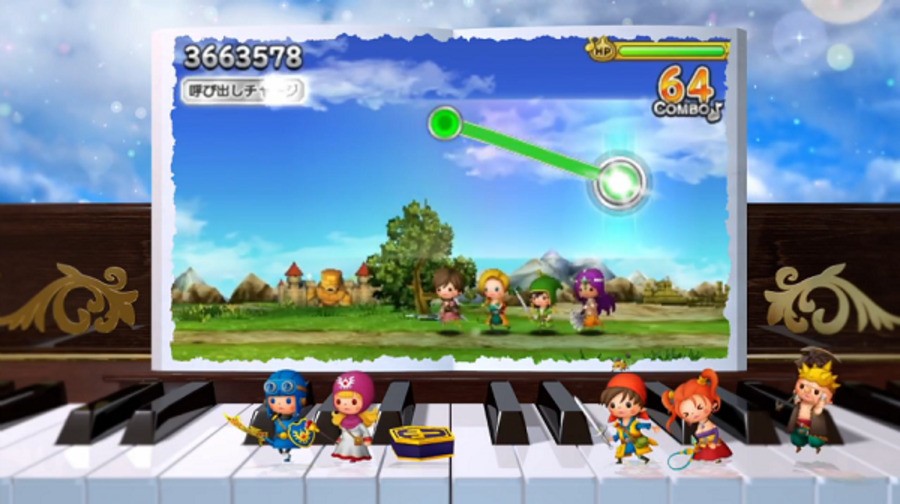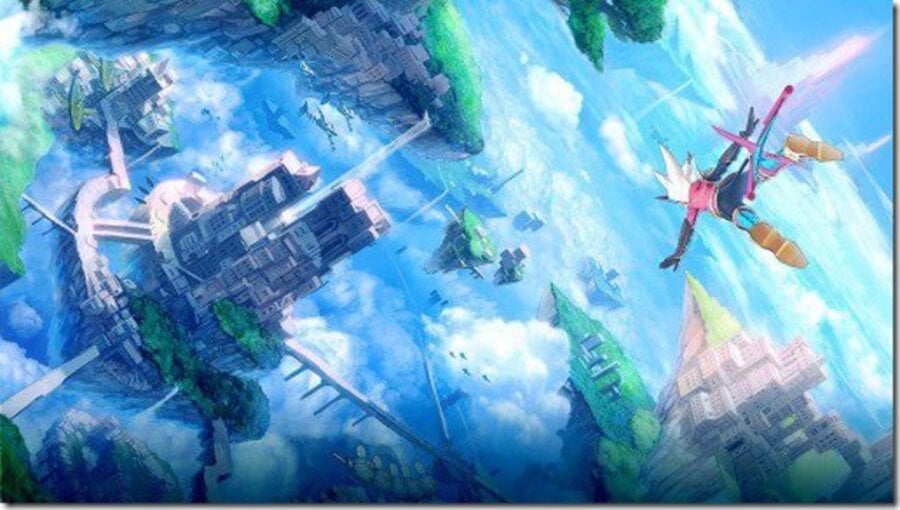Finally — this week's Famitsu has made up for the last couple of disappointing releases when it comes to juicy Nintendo news. While we still haven't heard when Bravely Second: End Layer will make it outside of Japan, that hasn't stopped Famitsu from feeding Japanese gamers more and more information on the sequel to one of the 3DS's best roleplaying games. Luckily, we've had a read through the four page spread featured in Famitsu this week, along with reviews of Theatrhythm Dragon Quest, Tengami, and Rodea the Sky Soldier.
Fair warning — some light spoilers for Bravely Second: End Layer are below.
Previews

Bravely Second's spread focused on unlockable jobs in the upcoming title. The original title, Bravely Default, had a whopping 23 jobs the four playable characters could switch between, and it appears Bravely Second isn't straying far from its predecessor's tree. Famitsu confirmed at least five jobs in the game, two new and three returning favourites.
First up is the Wizard job. Bravely Default had a half dozen magic jobs, but a Wizard wasn't one of them. Wizards use spirit magic in Bravely Second, and what makes them different from a black or red mage is their special "modification" ability. Modification allows Wizards to manipulate the properties of spells, such as its physical properties or area of effect. This job is unlocked by defeating a black sorceress from the Kingdom of Glanz named Ayame.
The Chariot job is also a new one to the series. Chariots are diverse physical attackers capable of using all types of weapons and come equipped with the ability to use three weapons at once. Yeah — you read that right. Three weapons at once. When players beat Ku Kurin, a half man and half horse sworn to serve Ayame, the job becomes available.
Fans of the Pirate, Swordmaster, and Performer (or Super Star) jobs will rejoice to hear all three return in Bravely Second: End Layer. For those with shoddy memories, Pirates wield axes and lower enemies' defenses, Swordmasters have powerful counterattack abilities, and Performers fill a support or bard type role. In an interesting twist, it appears Bravely Second and its predecessor share the same bosses protecting the Asterisk, which is an item conferred to the player after defeating said boss, which unlocks the job. Hayreddin Barbarossa returns with the Pirate Astrick, as does Nobutsuna Kamiizumi and Praline á la Mode for the Swordsmaster and Performer Asterisk, respectfully.
Of course, there was a bit more non-job related information floating around in Famitsu. Hold onto your pants because it appears that in Bravely Second: End Layer, players can create stuffed animals of a monster called a Kapukapu, which may or may not be called a Chomper in English — the translation wasn't quite clear. Players do so by participating in a minigame requiring the cooperation of all four party members. A special currency, called "Kapu" in Japanese, is then used to buy better Kapukapu making equipment or used to exchanged for other currencies. Furthermore, doing well in the minigame unlocks music, and we all know how good Bravely Default's music was.
Reviews

Are you a fan of Dragon Quest music? Well, Famitsu has some good news. Theatrhythm Dragon Quest, the spiritual sequel to the 3DS's superb Theatrhythm Final Fantasy, received a platinum award from Famitsu this week, which is high praise. All four Famitsu reviewers adored the game's art style, stating "along with characters you know and love and cute graphics, the dazzlingly famous music will carry you to blissful satisfaction." Wow. Maybe this is a good time to note that Japan is obsessed with Dragon Quest, quite a bit more than other countries are. Another reviewer appreciated the game's varied difficulty levels: "I loved how with different difficulty levels, as well as being able to disable features like the Slide Trigger, nearly anybody can play and enjoy the game."
However, not everything is peaches and rainbows with Theatrhythm Dragon Quest. Aiuchi, one of the reviewers, cited certain mechanics were difficult to see at times, adding frustration to an otherwise superb game. Aiuchi suggested that players may get used to the eye strain with time.

Tengami is a game sporting a popup book artstyle that Nintendo Life reviewed last year. Famitsu needs to step up its game! (Fine, we're being unfair, it arrived in Japan after the West) We digress — Tengami tasks the player with traveling through Japanese fairytales, and for the most part the reviewers enjoyed their time with it. "The game has a great Japanese atmosphere thanks to the graphics and sound," one reviewer noted, "but the characters were a bit small and I was always getting annoyed by the slow movement speed." Another found the GamePad inadequate to play the game with, while another reviewer made liberal use of the hint system to get through the game.

Rodea is a Wii U and 3DS game best described as being similar to NiGHTS into Dreams. It's a flying action game which uses either system's stylus to control the player character. The reviewers said the game required quite a bit to get used to, but "once you get the hang of it the feeling of freedom and exhilaration is amazing." "Fighting against giant enemies and the large scale of everything in the game feels good," another reviewer added. However, the reticle, energy meter, and cursor are all bunched together and make it hard to control, "which is especially bad in the 3DS version."
The game releases outside of Japan next fall.
And that's it for this week's cover of Famitsu. Hopefully, this marks the beginning of more dense Nintendo coverage in Japan's most popular gaming magazine.
What got you most jealous of Japan this week? Be sure to let us know in the comments.
Thank you once again Bill for your wonderful translations!


Comments 14
I'm still trying to finish the first... Definitely not ready for the second BD
@DarthNocturnal Yes it really is that good. It is far superior to 4 heroes in every way and doesn't suffer from those design flaws, though it does have one really big flaw of its own. I can't really say what it is without spoiling anything, but I can say that despite the second half of the game being practically ruined by it I still love the game to bits and wholeheartedly recommend it.
@EOTW
As i have played through the game i know what you mean and agree that it would be too big a spoiler BUT i can also agree that it is a GREAT game. I really hope that Bravely Second doesnt include the same flaw but i would play it anyway because the game is just so good.
Give the US that new Theatrhythm already! D=
Wait a second... what?! How can you get the Swordmaster asterisk from Kamiizumi again?! He doesn't have it anymore! And then there's another point that I won't call here because of spoilers...
@DarthNocturnal Nope. It's not a terrible game, but also not good, either.
Drawn-out and grind-heavy combat, paper-thin characters that seem to have been written by a 5-year-old, a story that fits the characters perfectly (meaning it's equally bad), and mediocre voice actors are the biggest flaws of the game. It could've been so much better, but instead is Final Fantasy I level quality, at best (except for the visuals, those are okay). All you've missed is an RPG that is painfully dull and clichéd.
Have they said how many jobs are in this one?
And so happy Praline is back! Love in the crossfire!!!
@ShadJV There's a new Praline song (it's on youtube).
@DarthNocturnal I think it's an awesome game. While it does have it's flaws, it makes up for those ten times over (and no game's perfect, anyway). Of course, not everyone's of the same opinion, but when I'm not sure about a game, I just buy it used.
On topic, I can't wait to try out all the new jobs I've heard about. And hooray for old Asterisks/Asterisk bearers coming back. Also, unlockable music. That just made my day.
While we're at it, Squenix, bring over the new Theatrhythm as well. Do it!
@EOTW @Xenjamin
Yup that is my dilemma right now
@Azikira: Agreed. Especially since all the DLC will be free, right?
Japan Weekly? Nintendolife plz - I despair enough knowing that Japan has all these awesome Dragon Quest games that we don't, now you're going to show how awesome they are on a weekly basis?
...So same time next week?
@arrmixer same here. It's really a great game and I need to finish it. I have the town repaired finally though.
Interesting news on Bravely Second, except for one key thing. We know that three of the main characters from the first game will be returning in some form or another, but the greatest of them all has not yet been confirmed as returning.
Praline is returning! Love in the crossfire, ready aim fire! We love you Praline!!
Should have been called Bravely Default: Second Mission
Show Comments
Leave A Comment
Hold on there, you need to login to post a comment...